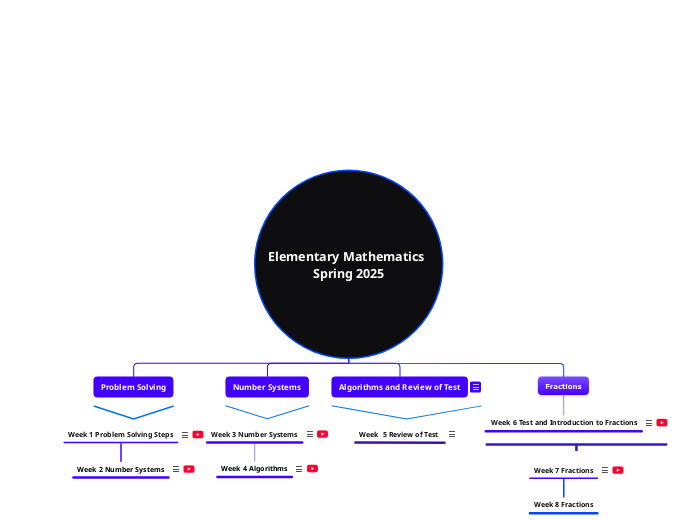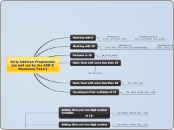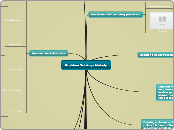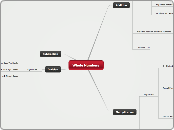Week 15 Decimals
Decimals are a type of fraction that you probably work with every day of your life. The following figures contain decimal fractions: $2.75, $8.08, $.20. As you already know they stand for dollars and cents, and the point separates the dollars from the change. But, have you ever thought about why cents are always written to the right of a point?
Since there are 100 cents in a dollar, cents are 100ths of a dollar. In the figures above seventy-five pennies is 75/100 of a dollar; eight pennies is 8/100 of a dollar; twenty pennies is 20/100 of a dollar. The decimal point tells you that everything to the right of it is a part or a fraction of a dollar.
In our money system, decimal fractions only go up to hundredths; however, decimal fractions can go from tenths to millionths when they are used for certain types of exact measurement. Since decimal fractions don't have bottom numbers, you read them by noting the number of places they take up to the right of the decimal point.
Decimals are arranged by 10's only - 10ths, 100ths, 1,000ths, 10,000ths, 100,000ths, 1,000,000ths.
Any number to the left of the decimal point is a read as a whole number.
Any number to the right of the decimal point is a decimal fraction. The number of places to the right of the decimal point will tell you the decimal name of that fraction. Remeber to use the word "and" to separate the whole number from the decimal fraction.
When writing decimals from words, be sure that you have the correct number of places, and watch for the word and.
To change a decimal to a fraction (or a mixed decimal to a mixed number), write the figures in the decimal fraction as the top number and write the bottom number according to the number of places used.
For example:
Change .24 to a common fraction
Step 1. Write 24 as the top number.
Step 2. Two places means hundredths. Write 100 as the bottom number.
Step 3. Reduce the fraction. 24/100. 24 and 100 can be divided by 4. 24/100 = 6/25
To change a fraction to a decimal, divide the bottom number into the top number. To do this, add a decimal point and zeros to the top number. Usually, two zeros are enough. Bring the point up into the answer.
For example:
Change 1/2 to a decimal
Step 1. Divide the bottom number 2 into the top number - 1.
Step 2. Add a decimal point and zeros. Divide and bring the point up.
Here, one zero was enough to complete the division problem. Answer is .5
Comparing decimals: when you look at a group of decimal fractions, it is sometimes difficult to tell which one is the largest. Here is a trick you can use to compare decimals. To compare decimals, give each decimal you are comparing the same number of places by adding zeros. This is the same as giving each decimal a common denominator.
Adding Decimals:
To add decimals, first line them up with point under point. Remember: Any whole number is understood to have a decimal point at its right.
Subtracting Decimals:
To subtract decimals, put the larger number on top, line up the decimal points, add zeros to the right so that each decimal has the same number of places, and subtract as you would for whole numbers, bringing down the decimal point.
Multiplying Decimals:
To multiply decimals, multiply the two numbers the same way you would whole numbers. Then count the number of decimal places in both numbers you are multiplying. Decimal places are numbers to the right of the decimal point. Put the total number of places in your answer.
You may need to add zeros in front of your answer to have enough decimal places in the final answer.
Multiplying Decimals by 10, 100, 1,000. There are shortcuts you can use when multiplying decimals by 10, 100, and 1,000.
To multiply a decimal by 10, move the decimal point one place to the right.
To multiply a decimal by 100, move the decimal point two places to the right.
To multiply a decimal by 1000, move the decimal point three places to the right.
Dividing Decimals by whole numbers:
To divide a decimal by a whole number, bring the point up in the answer directly above its position in the problem. Then divide as you would whole numbers.
To divide by a decimal, you must change the problem to a problem in which you are dividing by a whole number.
Step 1. Move the point in the number outside the bracket (the divisor) to the right as far as it will go.
Step. 2. Move the point in the number inside the bracket (the dividend) the same number of places that you moved the point in the divisor.
Step 3. Bring the point up in the answer directly above its new position in the dividend and divide.
Sometimes you need to add zeros in your problem in order to have enough places to move the decimal point.
Dividing whole numbers by decimals:
When dividing a decimal into a whole number, put a point after the whole number and add zeros in order to move the point enough places. Remember, a whole number is understood to have a decimal point at its right.
Dividing decimals by 10, 100, and d1,000.
There are shortcuts you can use when dividing decimals by 10, 100, and 1,000.
To divide a decimal by 10, move the decimal point one place to the left.
To divide a decimal by 100, move the decimal point two places to the left.
To divide a decimal by 1,000, move the decimal point three places to the left.
Week 16 Decimals
Notes
Week 13 Decimals
Percent means "out of one hundred."
Think: 100 cents make one dollar, and 100 cm makes one meter.
100% means 100/100 or 1
If percent means out of one hundred, converting percent to a fraction or a decimal is very easy.
85% means 85 out of 100
85% equals 85/100
85/100 equals 0.85
To change from decimal to percent, we do the opposite.
Changing fractions to percent is a bit trickier. We have to change the fraction to a decimal first and then to a percent.
If your fraction can be turned into an equivalent fraction with a denominator of 10 or 100, things are very easy.
If your fraction cannot be turned into an equivalent fraction with a denominator of 10 or 100, then you have to actually carry out the division.
There are 3 types of problems with percents:
- _____________ is what percent of _____________?
- ___________% of ________ is what number?
- ________% of what number is ___________?
The easiest way to solve these problems is to turn them into an equation, remembering that "is" means =.
"of" means multiply.
"what" means the variable n.
Change % into decimals, and "what percent" write the decimal as a percent
Week 14 Decimals
Pi is irrational. Pi is not a decimal.
Place value to the left of the decimal:
ones
tens
hundreds
thousands
ten thousands
hundred thousands
millions
Place value to the right of the decimal:
tenths
hundredths
thousandths
ten thousandths
hundred thousandths
millionths
Decimal point separates the whole from the part.
The decimal point sits to the right of the unit.
We do not have oneths' because one is the unit. It is the unit that gets smaller by ten times.
What is a terminating decimal? 1/8 is a terminating decimals because 1/8 = .125. It is a terminating decimal because when divided there arn't any remainders.
Week 1 Problem Solving Steps
A process standard, an essential component in every classroom.
Problem Solving Steps:
1. Understand/Communicate
2. Devise a Plan/Strategize
3. Implement Plan
4. Look Back/Check your answer.
Is this reasonable?
Invented by George Polya (Einstein's Son's advisor)
Week 2 Number Systems
A numeration system is a system for representing quantity of a number in a consistent manner
There are 10 digits (numerals): 0,1,2,3,4,5,6,7,8,9
Using the ten digits every number can be written.
Base 10 means using the ten different digits to write numbers. Digits (numerals): 0,1,2,3,4,5,6,7,8,9.
Base 10 = Decimal System
Decimal System is positional which means that the placement of digits (or numerals) in the number specifies the value of the number.
Base-5 (Quinary /ˈkwaɪnəri/ or pental) is a numeral system with five as the base.
5^0 = Ones = five to the 0
5^1 = Fives = five to the one
5^2 = 25's = five to the two
5^3 = 125's = five to the 3
Digits used in numeration system:
In Base 10 - 0,1,2,3,4,5,6,7,8,9
In Base 2 - 0,1
In Base 3 - 0,1,2
In Base 4 - 0,1,3
In Base 5 - 0,1,2,3,4
Expanded Notation:
Example:
723 = 700+20+3
723 = (7x100) + (2x10) + (3x1)
723 = (7x10^2) + (2x10^1) + (3x10^0)
IMPORTANT: Exponent operations do not have a commutative property. AND, the ^ symbol is used to represent an exponent.
Week 10 Fractions
A fraction is a symbol that shows the relationship between a part and a whole.
Which is more:
3/7 or 1/7 (3/7 is more)
4/5 or 4/9 (4/5 is more)
3/7 or 5/8 (5/8 is more)
3/4 or 9/10 (9/10 is more)
7/8 or 8/7 (8/7 is more)
Meanings of Fractions:
- Part-Whole
- Quotient: this meaning comes from division 3:5 = 3/5
- Ratio (a ratio is not a fraction) Ratio shows the relationship part-to-part, however, part/whole ratio is a fraction.
Models: of fractions:
-area: pattern black shading, pattern blocks, pie pieces, shading paper.
-length: number line, line segments, fraction bars, folding paper
-sets: groups of things
Whole: when the numerator and denominator are the same.
Addition and subtraction solve by keeping the same denominator. Use the least common multiple to solve an improper addition and subtraction fraction problem.
Week 11 Fractions
Divisibility Rules:
a is divisible by b, if there is a number c that meets the requirement.
A number is divisible by a second number if the second number divides into the first number with no remainder.
A number is divisible by 2 if it ends in 0, 2, 4, 6, or 8.
A number is divisible by 3 if the sum of its digits is also divided by 3. Add each digit and check the result, is it divisible by 3.
A number is divisible by 4 if the last two digits of the number are divisible by 4. Look at the number. Ask yourself, are the last 2 digits divisible by 4.
A number is divisible by 5 if it ends in 5 or 0.
A number is divisible by 6 if it is divisible by BOTH 2 and 3.
A number is divisible by 7 if the following works:
Double the last digit. Then subtract it from the remaining number. If the result is divisible by 7, so is the original number. Apply this rule as many times as needed.
A number is divisible by 8 if the last three digits are divisible by 8.
A number is divisible by 9 if the sum of its digits is divisible by 9.
A number is divisible by 10 if it ends with 0.
A number is divisible by 11 if the following rule works.
Chop off the last two digits of your number. Add them to what it is left of the original number. Repeat until you have two digits. If the digits are the same, then your original number is divided by 11.
A prime number has exactly two factors: one and itself.
The prime numbers through 60 are; 2, 3, 5, 7, 11, 13, 17, 19, 23, 29, 31, 37, 41, 43, 47, 53, 59.
A composite number is a number with more than two factors.
Zero and one are very special numbers in out number system. 0 is the identity additive element. 1 is the multiplicative identity element. Zero and one are neither prime nor composite numbers.
Week 12 Fractions Review & Test
Week 7 Fractions
Fractions:
A fraction is a part of something.
A penny is a fraction of a dollar.
The two numbers in a fraction are called the numerator and denominator.
Numerator is over the denominator:
Numerator - which tells how many parts you have
Denominator - which tells how many parts in the whole
Forms of Fractions:
Proper fraction The top number is less than the bottom number.
Improper fraction The top number is equal to or larger than the bottom number.
Mixed number A whole number is written next to a proper fraction
Reducing a fraction means writing it an easier way - with smaller numbers. When you reduce a fraction the value does not change. A reduced fraction is equal to the original fraction. When you have reduced a fraction as much as possible, the fraction is then in lowest terms.
Reduce: 20
30
In multiplication, when both the top and bottom numbers end with 0's, cross out the 0's. Then check to see if you can continue to reduce.
Raising fractions to higher terms is the opposite of reducing a fraction to lowest terms. Steps follow:
Step 1: Divide the old bottom number into the new one (the number you want to raise to). Keep the bottom number as the number you want to raise to ( the new one).
Step 2: Multiply the answer by the old top number. Place it on the top.
Check: Reduce the new fraction to see if you get the original fraction.
Changing improper fraction to whole or mixed numbers.
An improper fraction is a fraction with the top number that is big or bigger than the bottom number. An improper fraction is equal to or larger than one whole.
Change an improper fraction by dividing the bottom number into the top number and writing the remainder. Steps follow:
Step 1: Divide the bottom into the top
Step 2: Write the remainder as a fraction over the original bottom.
Step 3: Reduce the remaining fraction.
Changing mixed numbers to improper fractions. Steps follow:
Step 1: Multipy the bottom number by the whole number.
Step 2: Add the result to the top number.
Step 3: Place the total over the bottom number.
Week 8 Fractions
A prime number is a natural number greater than 1 that is not a product of two smaller natural numbers.
A natural number greater than 1 that is not prime is called a composite number.
Composite numbers have lots of factors.
1 is neither prime or composite because it is the identity element of multiplication. It is the multiplicative identity element.
0 is neither prime or composite because 0 is the identity element of addition. It is the additive identity element.
Prime factorizaton of 24 is as follows:
24: 1, 2, 3, 4, 6, 8, 12, 24
Prime factorization of 28 is as follows:
28: 1, 2, 4, 7, 14, 28
Prime factorization of 30 is as follows:
30: 1, 2, 3, 5, 6, 10, 15, 30
Prime factorization of 36 is as follows:
36: 1, 2, 3, 4, 6, 9, 12,18, 36
Prime factorization of 90 is as follows:
91: 1, 7, 13, 91
Prime factorization of 42 is as follows:
42: 1, 2, 3, 6, 7, 14, 21, 42
The prime numbers of 60 are as follows:
2, 3, 5, 7, 11, 13, 17, 19, 23, 29, 31, 37, 41, 43, 47, 54, 59
Week 9 Spring Break
Prime factorization:
If I take any of the factors of a number, I can create a factorization tree.
GCF: Greatest Common Factor.
We use greatest common factors when we simplify fractions.
GCF is used when we simplify fractions.
LCM: Least Common Multiple.
Multiples reminds you of "skip" counting.
LCM is used to find a common denominator to create equivalent fractions.
LCD: Lowest (least) Common Denominator
If the fractions in an addition problem do not have the same bottom numbers (denominators), you must rewrite the problem so that all of the fractions have the same bottom number (called a common denominator).
This will mean raising at least one of the fractions to higher terms.
A common denominator is a number that can be divided evenly by all of the denominators in the problem.
The smallest number that can be divided evenly by all of the denominators in the problem is called the lowest common denominator or LCD. Sometimes, the largest denominator in the problem will work as the LCD.
Week 3 Number Systems
PROPERTIES:
Properties of Multiplication:
- Identity property: when I multiply a number by one, the number does not change.
- Commutative property (aka Order Property): the order property is the order in which I multiply the number does not matter. Changing the order of factors doesn't change the product.
- Associative property: when grouping, what changes is the way I group. The outcome is always the same in the problem.
- Zero property: when I multipy a number by zero, the answer is always zero.
Division does not have properties. Division, in a sense is the opposite of multiplication.
Properties of Addition:
- Identity property: Adding zero to any number results in the original number.
- Commutative property: the order does not change the value. The order of the numbers being added does not change the sum.
- Associative property: means changing the grouping does not change the value. The order in which numbers are grouped when added does not change the sum.
- Distributive property: The sum of two numbers multiplied by a third number is equal to the sum of each number multiplied by the third number individually. Even if you distribute the numbers differently, they will solve to the same.
Subtraction does not have properties. Subtraction in a sense is the opposite of addition.
Week 4 Algorithms
Week 5 Review of Test
EXAMPLE of Addition Expanded Notation:
478 + 394 =
Solve using expanded notation:
400 + 70 + 8 =478
300 + 90 + 4 = 394
800 + 70 + 2 = 872
EXAMPLE of Subtraction Expanded Notation:
645 - 279 = 366
Solve using Expanded Notation of Subtraction:
_ 600 + 40 + 5 =
200 + 70 + 9 =
300 + 60 + 6 = 366
Elementary Mathematics
Spring 2025
Type in the name of your subject.
Decimals
Fractions
Week 6 Test & Number Theory
Divisibility rules:
When a # is divisible by a number without remainders?
a is divisible by another, b if there is a number c. that meets the requirement.
A number that divides a number are also factors of that number.
Factor: a number or quantity that when multiplied with another produces a given number or expression.
Divisibility rules for 2, 3, 4, 5, 6, 7, 8, 9, 10 & 11:
Divisibility rule for 2.
2: 0, 2, 4, 6, 8
meaning look for even numbers. So if the number has a 0, 2, 4, 6, or 8, then be assured it is divisible by 2.
Divisibility rule for 3.
3: if the sum of the digits is divisible by 3.
We will add up all the digits and divide the sum by 3.
Divisibility rule for 4.
4:
We need to pick the last two digits, and divide it by 4, if it leaves no remainders, the number is divisible by 4.
If last 2 digits are divisible by 4.
Divisibility rule for 5.
5: 0, 5
A number is divisible by 5 if it has 0 or 5 it its ones place (at the end of the number).
Divisibility rule for 6.
6:
If it's divisible by both 2 and 3.
If a number is divisible by 2 and 3, then it is divisible by 6 as well.
If it is divisible by both 2 and 3. Lets look at divisibility rule for 2: If a number has 0, 2, 4, 6, or 8 as its last digit, then be assured it is divisible by 2. Lets look at dvisibility rule for 3: We'll add up all the digits, and divide the sum by 3. Passes the divisibility test if "no remainders."
Divisibility rule for 7.
7:
There are 3 steps to determine the divisiblity:
Step 1: double the last digit, meaning 2 x the last digit = this number.
Step 2: Remove that last number, the last digit. Then subtract the result, from that number on the left of the last number. Take the other number, that is doubled, and subtract it from the number to the left.
Step 3: if the difference is divisible by 7, then the number is divisible by 7.
Double last digit, (2 x itself), then subtract that number from remaining number, and repeat.
Divisibility rule for 8.
8:
If the last three digits are divisible by 8, then the number is divisible by 8.
If the last 3 digits are divisible by 8.
Divisibility rule for 9.
9:
Add up all the digits and divide the number by 9.
If the sum of digits is divisible by 9.
Divisibility rule for 10.
10: 0
If the number ends with 0, then it is divisible by 10.
Divisibility rule for 11.
11:
The "chop off" method.
- Chop off the last 2 digits.
- Add them to remaining number
- repeat.
Algorithms and Review of Test
Algorithm is a process or set of rules to be followed in calculations or other problem-solving operations, especially by a computer.
Addition Algorithms:
- American Standard
- Partial Sums
- Partial Sums with Place Value
- Solve Left to Right
- Expanded Notation
- Lattice Methods
Subtraction Algorithms:
- American Standard
- Reverse Indian
- Solve Left to Right
- Expanded Notation
- Integer Subtraction
Multiplication Algorithms:
- American Standard
- Place Value
- Expanded Notation
- Lattice Method
Add detailed notes about each lecture, so that when the time comes to prepare for exams, you will have an easier and quicker overview.
Number Systems
Add here all the details about your projects.
Problem Solving
Schedule your course ahead. Knowing all the information will make everything easier.









